Editor’s Note: This week we’re at the 233rd AAS Meeting in Seattle, WA. Along with a team of authors from Astrobites, we will be writing updates on selected events at the meeting and posting each day. Follow along here or at astrobites.com. The usual posting schedule for AAS Nova will resume next week.
Plenary Talk: A Color Out of Space: ‘Oumuamua’s Brief and Mysterious Visit to the Solar System (by Stephanie Hamilton)
The first plenary session of #AAS233 kicked off with a presentation by Hawai’i native Ka’iu Kimura describing the work of the ‘Imiloa Astronomy Center, an astronomy and culture education center in Hilo, HI that showcases the role of Hawai’ian culture in astronomy. The long history of tension between Hawai’i natives and astronomers regarding the development of Mauna Kea has made the subsequent development of ‘Imiloa difficult. The Center features exhibits and displays of Hawai’ian culture on one side (the “brown carpet”) and showcases astronomy displays on the other (the “blue carpet”). But the mere presence of the two topics in the same space has opened opportunities for discussions about each in the realm of the other.
‘Imiloa’s role in astronomy reached new heights with the discovery of the first-ever interstellar asteroid, ‘Oumuamua. Kimura recalled her experience with naming ‘Oumuamua — Doug Simons, executive director of the Canada-France-Hawai’i Telescope (with which the object was discovered), contacted her asking for a Hawai’ian name “within the next 48 hours.” Her uncle, an advocate for Hawai’ian culture, suggested the name ‘Oumuamua, which translates to “scout or messenger from the distant past.” At that time, ‘Imiloa had already been developing a process for naming astronomical objects and ‘Oumuamua provided the first test of that process. Now a pilot program called A Hua He Inoa invites a group of 10 students to study and name asteroids. They have already named two: 1) Kamo’oalewa, one member of a dissociated binary object now left to orbit in the solar system on its own, and 2) Ka’epaoka’awela, a retrograde asteroid near Jupiter.
The plenary session continued with Yale’s Dr. Gregory Laughlin’s overview of the discovery and study of ‘Oumuamua. Due to the unfortunate lack of Hawai’ian words in the English language, Laughlin commented on his phone’s habit of autocorrecting ‘Oumuamua, until it eventually started autocorrecting everything else to ‘Oumuamua:
“I had the honor of asking the plumber who came to fix our clogged drain if he could 'Oumuamua” — @greg_laughlin_ #aas233 #betterwithoutcontext
— Nadia Drake (@nadiamdrake) January 7, 2019
Discovered on 25 October 2017, ‘Oumuamua was visible until just last month, December 2018. It was discovered at a distance of just 60 lunar distances, whizzing by with a velocity of 26 km/s. It reached its closest approach to the Sun of 0.25 astronomical units at 88 km/s before leaving our solar system forever.
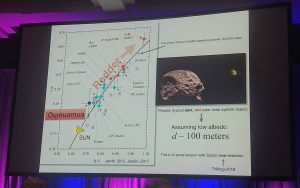
The properties of ‘Oumuamua. The left plot shows that the object (black circle) resembles bodies in our own solar system. Assuming low albedo (reflectance), astronomers calculate its size to be ~100m.
After the discovery announcement, there was a mad scramble to obtain observations before ‘Oumuamua got too faint, particularly for spectroscopy. The Palomar telescope showed a relatively boring spectrum — red and featureless, similar to many of the bodies in our own solar system. Additional observations of ‘Oumuamua’s light curve suggested a rotation period of ~8 hours. But what was truly remarkable was the variation in the light curve — almost 3 magnitudes from brightest to faintest! No other object that astronomers have studied shows nearly that degree of variation, and it offers clues to ‘Oumuamua’s size and shape. It is not a contact binary since such an object would have been disrupted, and we know that it must be extremely elongated (latest estimates calculate the ratio of the long axis to short axis at ~5:1) due to the extreme light curve variation.
‘Oumuamua’s surprises didn’t stop there: astronomers then found that their observations fit better if the object was accelerating, e.g. due to outgassing. Laughlin and collaborators have developed a model of outgassing on a triaxial cylindrical object (like what ‘Oumuamua is thought to be) that matches the observed variations in the light curve quite well. Look out for that paper coming soon to an arXiv near you!
Press Conference: Stars & Planets from SOFIA, Spitzer & Citizen Scientists (by Susanna Kohler)
As AAS Press Officer Rick Fienberg noted, the first press conference of AAS 233 was a historical event: it marked the very first conference in which the entire press corps donned 3D glasses! Beautiful visuals and exciting discoveries populated this session.
Alexander Tielens (Leiden University) opened the conference by announcing new infrared observations from the GREAT instrument on NASA’s Stratospheric Observatory for Infrared Astronomy (SOFIA), an infrared telescope that flies in the stratosphere on a modified 747 jetliner. GREAT’s observations were of the center of the Orion nebula, where the massive star θ1 Ori C is gradually blowing a bubble in its surrounding molecular cloud. Astronomers have long suspected that stellar winds from massive stars might be responsible for removing material and halting further star formation. Now SOFIA’s observations have caught θ1 Ori C in the act of destroying its natal environment, lending support to this theory. Press release

A screenshot of Orion’s Dragon, taken from the 3D video of the Orion nebula created from SOFIA infrared data. [NASA/SOFIA]
Next up, Thomas Beatty (University of Arizona) detailed the results of a study of hot Jupiters, large gaseous exoplanets that orbit very close to their host stars and are tidally locked — i.e., the same side of the planet always faces the star. New observations from Spitzer suggest that these planets all have clouds on their night sides (the side facing away from the star) and are all clear on their day sides (the side facing toward the star). Press release

Artist’s illustration of newfound planet K2-288Bb, which was discovered by citizen scientists. [NASA’s Goddard SFC/Francis Reddy]
Lastly, Kevin Hardegree-Ullman (California Institute of Technology) rounded out the session by sharing a follow-up discovery in the citizen-scientist-discovered planetary system of K2-138. This star was determined last year to host five planets, and there were tantalizing hints that there may be a sixth lying further out. Using recent Spitzer observations, scientists have now confirmed the presence of that sixth planet, K2-138g. This is the ninth known planetary system with six or more planets — and there may be more planets hiding between K2-138g and the five inner planets, so we should definitely keep looking! Press release
Plenary Talk: The Dawn of Gravitational Wave Astrophysics (by Mike Zevin)
In the second plenary talk of AAS 233, Vicky Kalogera of Northwestern University illuminated the dawn of gravitational-wave astrophysics in her Dannie Heineman Prize Lecture. Kalogera is an astrophysicist in the LIGO Scientific Collaboration, though her group’s research interests span a range of topics in high-energy astrophysics, such as gravitational-wave data analysis, modeling of compact-object populations, the evolution of massive stars in binary systems, X-ray binaries, and supernovae.
In this talk, Kalogera covered the exciting progressions in the field of gravitational-wave astrophysics over the past few years — from the first observation of a binary black hole merger in September 2015 to the 10 binary black holes discovered to date (and who can forget the infamous binary-neutron star merger detected in gravitational waves as well as across the electromagnetic spectrum). Extracting information about the compact objects that created the signals (such as their masses, spins, and redshift) provides a unique and unprecedented probe into the population of merging compact objects in our universe.Kalogera stressed how influential these detections have been for confirming predicted rates of compact-object mergers, and in some cases, vastly exceeded predictions. The rates of double neutron star mergers is amazingly spot-on with predictions from almost a decade before the first binary neutron star mergers were observed. Black hole mergers, on the other hand, vastly exceeded expectations — the rate of such mergers were found to be about 10 times higher than theoretical predictions! How the past few years have changed our understanding of black hole merger rates it quite astounding — before the first gravitational-wave detection, the uncertainty of black hole merger rates spanned a few orders of magnitude. After a single detection, the rate uncertainty went down to a factor of 200, and after 10 detections it shrunk to an uncertainty factor of just 4!
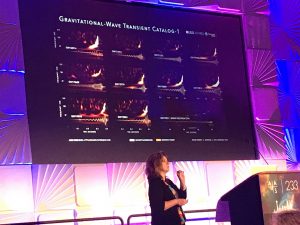
Vicky Kalogera presents the spectrograms and waveforms for LIGO-discovered gravitational-wave transients.
One exciting finding that gravitational-wave observations have already unveiled has to do with the mass spectrum of black holes — that is, the relative rate at which the universe churns out black holes of a given mass compared to other masses. Stellar evolution and supernova theory predicts multiple mass gaps — dearths in the mass spectrum of compact objects. With the 10 binary black hole observations to date, we are beginning to see definitive evidence of an upper mass gap due to a theorized type of supernova known as pulsational pair instability supernovae. 99% of the black hole population detected by LIGO have masses lower ~45 solar masses, right in line with where this predicted ‘gap’ starts. This is an excellent example of the corroboration of theoretical predictions with observational data, and it exemplifies the power that gravitational-wave observations have in deciphering the mysteries of our universe.
Lastly, Kalogera alludes to the upcoming years of operation of gravitational-wave detectors. In the next observing run of the LIGO and Virgo interferometers, which are expected to continue observations in March 2019, we can expect to observe up to a few black hole mergers per week and possibly a neutron star merger as frequently as once per month! Gravitational-wave scientists will certainly have their hands full, and the future of gravitational-wave astronomy will assuredly unveil more secrets about the dark universe.
Special Session: Know Your Power (by Mia de los Reyes)
Astrobites was one of the sponsors of the Know Your Power special session, run by Lauren Chambers, Leah Fulmer, and Dra. Nicole Cabrera Salazar. This special session aimed to address several questions: how do we recognize and leverage our power in academia to effect positive change? How do we collaborate with others, particularly those at different career stages and with different identities? As defined in this session, “power” is “the collection of authority, credibility, and knowledge that allows one to enact their autonomy and influence their environment.”
Just went to an awesome session at the AAS meeting called "Know Your Power". We need more sessions like these! #AAS233 #KnowYourPowerAAS
— Zoheyr 'not-a-👨🏾⚕️' Doctor (@almostdrdoctor) January 7, 2019
The session began by acknowledging that the #AAS233 meeting is occupying land traditionally belonging to the Duwamish and Puget Sound Salish peoples. The organizers further recognized the labor of the facilities and cleaning staff who have enabled this conference and all academic work. Finally, the organizers then reviewed some basic guidelines and reminded attendees to keep in mind the concept of “positionality”: the idea that we all have unique perspectives as a result of our unique intersections of identity.
Dra. Cabrera Salazar then moderated a panel discussion among a group of accomplished astronomers from all levels of academia. The panelists gave examples from their own lives and careers of how they’ve used their power to cause positive change, which led to some great discussions on various related topics: how to be a good collaborator when pushing for change (a key point is to listen and learn), how to use available resources (such as networks, opportunities, and awards) to uplift ourselves and others, and how to work together as a collective to amplify our individual power within the system of academia.
The session then broke into small group discussions, where attendees were able to talk among themselves about their own ways to use power to promote change. The discussion questions guided attendees to think about actionable ways to advocate for a more equitable and inclusive environment in academia — and about how to hold ourselves accountable. Several organizations were mentioned for their work in fostering inclusivity, including the Banneker-Aztlán Institute and the National Astronomy Consortium.
Even after the session officially finished, the organizers noted that the work isn’t over. The Know Your Power document is a compilation of suggestions for ways that people at all different academic career stages can use their power. We invite you to contact the organizers if you’re interested in contributing to this living document!
Press Conference: Early Science from the Transiting Exoplanet Survey Satellite (TESS) (by Caitlin Doughty)
The Transiting Exoplanet Survey Satellite (TESS) is an all-sky survey with a 2-year prime mission: to target main-sequence dwarf stars in the ever-expanding search for exoplanets. Having launched in April 2018 and begun science operations the following July once it reached its lunar orbit, the satellite works by using its four cameras to cover what the TESS team calls a sector of the sky, stacking many integrations taken over the course of 30 minutes into one final image. It remains trained on this sector for 27 days, taking images all the while, before re-positioning itself to observe a new field. In total, TESS will observe 26 such sectors, covering more than 85% of the sky. In contrast, the Kepler Space Telescope, reigning king of exoplanet-discoverers, by design was only able to observe 0.25% of the sky. Per the status report given by George Ricker of MIT, TESS has completed observations of its 6th sector and the team put out the first data release in December 2018. Over 1 million files of TESS data have been downloaded, amounting to more than 67 terabytes of information.
17,583 DV time series downloaded from @stsci in the first week after @NASA_TESS data release! People want those details #aas233 pic.twitter.com/fB1ywTwA1L
— Doug Caldwell (@dacmess) January 7, 2019
Xu Chelsea Huang (MIT) reported on some early science results pertaining to planet discoveries. From preliminary analysis, over 300 exoplanet candidates were found (roughly 42 of which were re-discoveries of previously known exoplanets). Eight of these candidates have been confirmed from follow-up observations. In particular, Huang highlighted three of the eight: Pi Mensae c, LHS 3844 b, and HD21749 b. Pi Mensae c is the first exoplanet discovered by TESS and is a super-Earth with a radius of 57 times that of Earth. LHS 3844 b is a rocky planet only about 30% larger than Earth in diameter, but it is so close to its host star that it is probably a “lava world.” HD21749 b is a sub-Neptune gas giant with about 23 times the mass of Earth that orbits its host star in 36 days. The host star is also believed to possess a 2nd planet, roughly Earth-sized, but this has yet to be confirmed.
Michael Fausnaugh (MIT) reported on some early science results of studying astronomical transients with TESS. One of the interesting capabilities of TESS is that because it is an in-progress survey of a large part of the sky, astronomers can reference images with timestamps coinciding with reported transient events to help determine the cause of the event, or to study the object in the time leading up to its outburst. As proof of concept, Fausnaugh cited a reported event that occurred on August 3, 2018, where an odd brightening was observed in the sky. Since TESS had observed the same patch of sky, TESS data from a few days prior to the event was examined and astronomers were able to identify it as a stellar flare. For such a brief event, there would otherwise have been no other way to determine the cause once it died down, highlighting the utility of the TESS mission. Changing the subject to supernovae, in a single month of observation, TESS was able to capture six supernovae’s light curves. This mission will prove invaluable for studying their early light curves before they’ve achieved their maximum brightness, which can help astronomers distinguish between different progenitor scenarios.
How the @NASA_TESS mission will expand our knowledge of exoplanetary systems close to Earth (and thus good for follow-up studies): what was known before, the three discoveries by the TESS mission so far and what is expected at its end. From the 2nd #AAS233 press conference. pic.twitter.com/wgqkXbqbSg
— Daniel Fischer (@cosmos4u) January 7, 2019
The last of the updates came from Thomas Barclay (Goddard Space Flight Center & University of Maryland, Baltimore County), who was sitting in for Paul Hertz and Patricia Boyd. The Guest Investigator Program with TESS provides funding to science proposals that utilize either the full-frame images or the raw 2-minute cadence data in TESS data releases. This program gives astronomers who are interested in doing science outside of the core goals of the mission the opportunity to receive the funding necessary to focus on this work. For Cycle 1 of this program, more than 140 proposals were received and the Cycle 2 submission deadline is February 28th, 2019.
Plenary Talk: “Make No Small Plans” (George Ellery Hale, 1868–1938) (by Kerry Hensley)
The first afternoon plenary was given by former AAS Historical Astronomy Division chair Marc Rothenberg, filling in for David DeVorkin (Senior Curator for the Space History Department of the Smithsonian), who was unable to travel to the meeting due to the US government shutdown. Rothenberg introduced the achievements of George Ellery Hale — a prolific solar observer, observatory founder, and visionary in the field of astronomy. As an astronomer, Hale is best known for his discovery of magnetic fields in sunspots, but his legacy extends far beyond the field of solar physics.
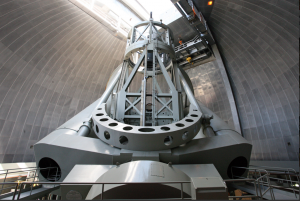
The 200-inch Hale Telescope at Palomar Observatory is still used for research today. (Palomar/Caltech)
Hale was not only interested in generating scientific results but also in developing the instruments that led to them. He constantly pushed for the construction of larger telescopes, from the 40-inch refracting telescope at the Yerkes Observatory (still the largest refracting telescope ever used for science) to the 200-inch (~5-meter) reflecting telescope at Palomar Observatory. (Built in 1948, the 200-inch telescope at Palomar was the world’s largest telescope until 1976!) This constant drive for progress reflects Hale’s personality as an “impulsive planner” who mapped out his next, larger project as soon as his current one was finished. (Hence his advice to friends and colleagues to “make no small plans.”)
However, not all scientists shared Hale’s enthusiasm for bigger and bigger telescopes: Edward C. Pickering (the director of the Harvard College Observatory) believed that we’d reached the useful limit in terms of telescope size. He thought that advances in astronomy expeditions, education, and prizes would lead to greater improvements in the field than spending more money on large telescopes. While the number of prizes has increased as Pickering hoped, telescopes have certainly continued to grow as well!
Hale’s lasting legacy also encompasses the institutions that he worked to found. He helped found the National Research Council during World War I as well as the Astronomical and Astrophysical Society of America, which later became the American Astronomical Society.
We just had a detailed description of George Ellery Hale’s scientific life and the tension between routine science and heroic great discoveries #aas233 pic.twitter.com/NWTCGz215M
— dfphil (@dfphil) January 8, 2019
Plenary Talk: The Obscured Early Universe (by Nora Shipp)
In the final plenary of the day, Caitlin Casey gave the Newton Lacy Pierce Prize lecture on unveiling the obscured universe. Casey, a professor at UT Austin, looks back the most massive and luminous galaxies in the early and distant universe, which form stars hundreds of times faster than the Milky Way. These extreme galaxies are essential for our understanding of galaxy formation in early epochs, but they are very difficult to study using usual methods, because their observations are altered by dust. Although dust makes up only a small fraction of the mass in galaxies, it can have a huge effect on the light galaxies produce, since it absorbs starlight and reradiates it at different wavelengths. For this reason, Casey does not use optical, ultraviolet, and infrared wavelengths like many astronomers; instead, she observes these distant galaxies at submillimeter wavelengths using the Atacama Large Millimeter Array (ALMA).
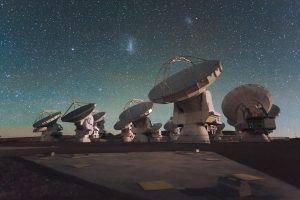
Antennas of the Atacama Large Millimeter/submillimeter Array (ALMA), on the Chajnantor Plateau in the Chilean Andes. [ESO/C. Malin]
- What do these extremely massive galaxies tell us about the most massive halos that could have formed at that point in the evolution of the universe?
- Are these unique systems formed through mergers, or via another mechanism?
- Are DSFGs the very first metal-enriched galaxies in the universe?
- Are they the progenitors of the most massive galaxy clusters that exist today?
Casey described how her research group at UT Austin has sought to answer these questions and produce a unified model of dusty galaxies at high redshifts. They have gathered all the available sub-mm data and compared it to various models embedded in mock observations. Casey suggested that for a more complete characterization, future shallow and wide-area submm surveys would be necessary to observe as many of these rare, massive, high-redshift, dusty galaxies as possible.
Caitlin Casey is putting her negative experiences in science in her plenary talk. We have known each other since teenagers at astronomy camp, and I’ve been proud of her many times, but never as much as now. #aas233 pic.twitter.com/xY5NQ8eifP
— Yvette Cendes (@whereisyvette) January 8, 2019
In addition to this exciting science, Casey took a few minutes to reflect on her experiences within the astronomy community. She thanked her mentors, colleagues, and friends throughout her career, and she acknowledged both the difficulties she has faced in reaching this point as well as the privileges that have made her path smoother than others. For graduate and undergraduate students in the room, it was encouraging and refreshing to hear that a decade ago this prize-winning researcher sat in this very audience, listening to a AAS prize talk, wondering whether she would ever make it. Prof. Casey’s journey is a reminder that the future of astronomy is bright!

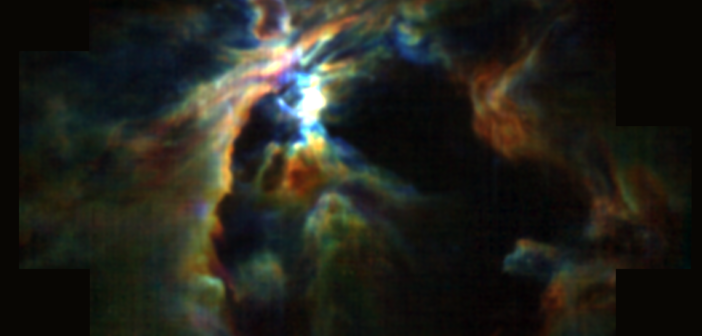
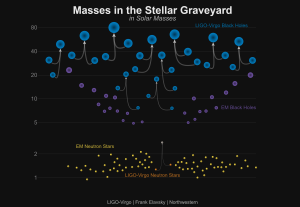
2 Comments
Pingback: AAS Nova – New
Pingback: AAS 233: Was sonst noch im Kosmos passierte | Skyweek Zwei Punkt Null